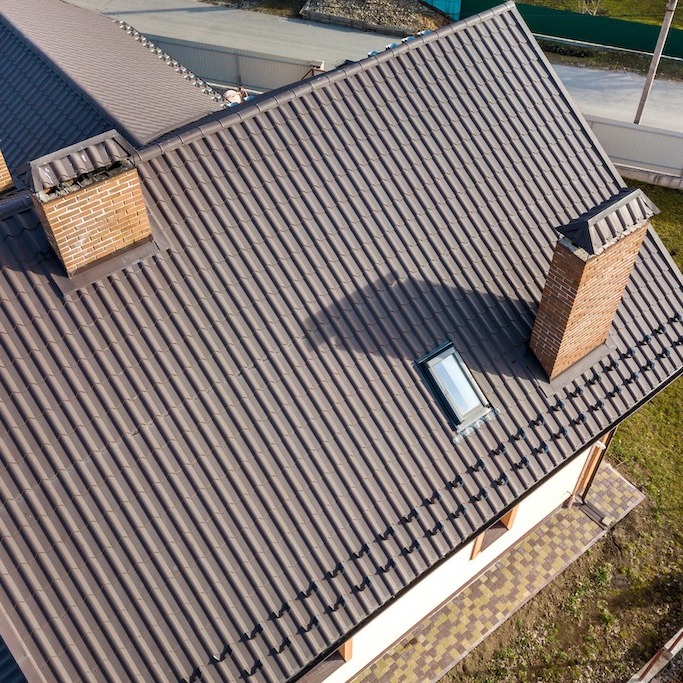
Learn More about Important Roof Structures
The traditional roofs on homes here in Canton, Georgia, and around the country have eight basic components:
- The roof decking.
- The metal drip edge.
- The underlayment.
- An ice and water shield.
- The exterior roofing material.
- The ridge cap.
- Roofing vents.
And last, but by no means least important and not an option, the roof flashing. What is roof flashing? Using asphalt shingled roofs as our example in this article, roof flashing is made of a thin metal material, typically galvanized steel. It is installed over and/or under the shingles as a layer of protection for the shingles in critical areas.
What are the critical areas that need roof flashing?
The areas where professional roofing contractors install roof flashing are where water could seep under the shingles, causing a roof leak. Those areas include the roof valleys, around chimneys, dormers, skylights, and vents. Another key area for roof flashing is along the roof planes where walls meet.
Roof flashing is installed in these areas to redirect water down the roof, into the gutter system. From there, the gutter runs send the water to the downspouts, and the water is redirected again out and away from the foundation.
Do all roofs need flashing?
Definitely! Without roof flashing, or if the roof flashing is damaged, deteriorated, or missing, the roof is susceptible to leaking in these critical areas. Once a leak begins on a roof, it has a cascading effect and will spread throughout the roof. Water is one of the most dangerous things when it comes to the structure of a home, and will cause damage, eventually destroying the entire structure.
Should roof flashing go over or under shingles?
It depends on where the flashing is being installed. Along the chimney, step flashing is installed which are squares of the metal roof flashing, overlapping between the shingles going along the chimney sides.
The basic roof flashing that is installed in the roof valleys is installed under the shingles. In this manner, as water cascades down the roof, it can’t get under the shingles and the roof valley acts like a gutter, keeping the water running.
Roof flashing is also installed around roof protrusions like the dormers, skylights, and vents. The flashing is usually integrated into the skylight’s design, and with dormers, it is installed like it is around the chimney, in “steps” with the shingles.
What are the options for roof flashing material?
There are several types of roof flashing that break into different categories, as we described some of the main ones above. The materials used for roof flashing can vary, but the most common is galvanized sheet metal. Why galvanized sheet metal? Because of its durability.
Aluminum is used in some instances because it is easier to work with, making installation easier. And on some high-end roofing, copper is used. There is also PVC roof flashing, while it is cheaper, you do get what you pay for, and it has a shorter lifespan than other roof flashing materials. A new product used for roof flashing is made with synthetic materials and composites, and the different properties of this roof flashing have proven to be easy to install and durable.
Are there any problems with roof flashing?
Yes, there can be problems with roof flashing that can lead to roof leaks and more damage if those problems are found and corrected. The problem that roof flashing can have includes getting old over time.
Like the roof itself, roof flashing ages too, and in areas where the temperatures fluctuate, the flashing often gets warped from the structure settling. On an asphalt shingled roof, the flashing should be replaced every 20 years, and when the roofing is replaced.
Another problem with roof flashing is the weather, like heavy rains and high winds. This is when you’ll find out if your roof flashing was installed correctly and is in good condition. The ice and snow that can cover a roof in the winter can weaken roof flashing too as the melting result of water gets under the flashing, and freezes, causing the flashing to come loose, this can lead to problems of roof leaks.
And the biggest problem with roof flashing is the initial installation. When it isn’t installed correctly, or if the roofing contractor takes shortcuts, leaks are sure to happen. And of course, accidental damage to the roof can damage the roof flashing, like tree limbs brushing against it in high winds, pulling it loose from the roof.
Keeping Things Moving
To summarize, roof flashing keeps the water moving in a way that the roof is protected. It is an essential component of the many components of a roof and should be inspected 2-3 times a year, especially after any significant weather that included hard rains and high winds.
When you need roof flashing replacement in Canton, GA, you need our team! We can handle your roofing issues with alacrity. Give us a call at 770-735-4433 to schedule an appointment today!
